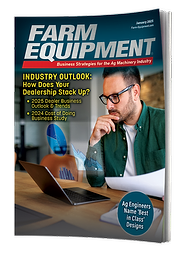Roller-Crimpers Help Terminate Cover Crops
Dave Brandt sells cover crop seeds with his son and daughter-in-law in central Ohio. He says Walnut Creek Seeds is focused on educating landowners and machinery retailers on the use of cover crops and how producers can lower their inputs and still maintain an adequate yield from the crop and soil they are working in.
“Dealers need to realize with cover crops it’s going to take the right amount of equipment (tractors, seeders, rollers) to do a good job, so we can place the seed at a proper depth and utilize the equipment best,” he says.
Brandt says a cover crop roller-crimper can mean the difference between the need for full herbicide, little herbicide or no herbicide application. If a cover crop is reaching maturity, it can be crimped and rolled. Brandt explains that in cereal rye, this is best done when the seed head is appearing and it sounds like popcorn popping as its being rolled.
Most cover crops will be 3-6 feet tall, and tough to get a planter through at that height. Brandt explains rolling and crimping it helps the farmer see better from the tractor and also eases the planter through the field. It lays the residue flat (2-4 inches thick) on the field surface, controls runoff from rain and keeps nutrients in the soil longer.
He says rollers are used on clovers too, and really any crop that makes a seed head. The timing is important, because the seed heads need to be present in order for the roller to fully terminate the crop. If it’s too early, the plant has a greater chance of surviving.
Brandt explains there are a few varieties of roller-crimpers available. Rite Way’s Crush-Rite has short roller sections with crimping edges offset from one section to the next, eliminating extra bounce in the field. I&J Manufacturing makes Rodale-style crimper-rollers, which have a Chevron on the roll itself, which looks like diagonal bars. They both work well, he says. Brandt has been no-tilling his land since 1971 and planting cover crops since 1978.
Brandt says a relationship with local dealers is hands-on. As a seed salesman, he appreciates when dealers are not afraid to refer customers to him for advice, especially as everyone heads into a new planting season. “We are able to encourage customers to maintain a high yield and do a better job using the soil the way it’s designed to be used,” he says.





